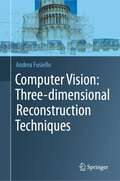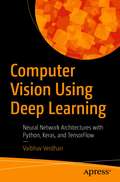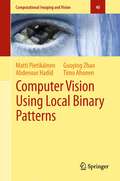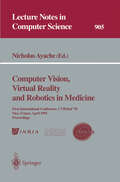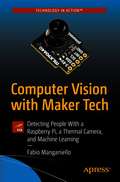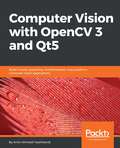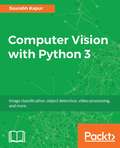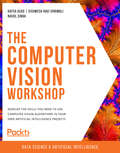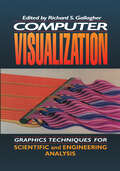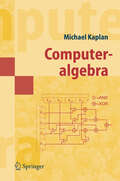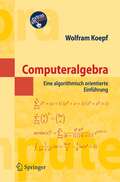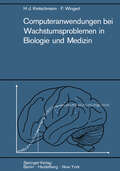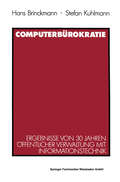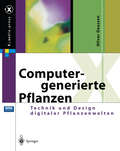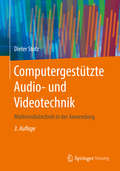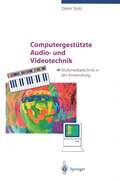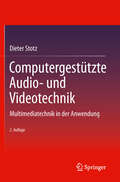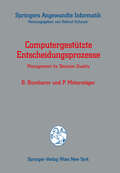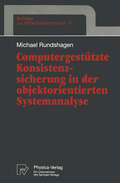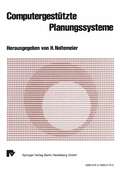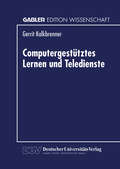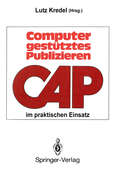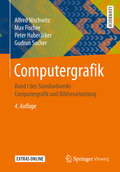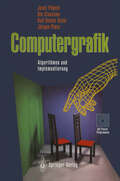- Table View
- List View
Computer Vision: Three-dimensional Reconstruction Techniques
by Andrea FusielloFrom facial recognition to self-driving cars, the applications of computer vision are vast and ever-expanding. Geometry plays a fundamental role in this discipline, providing the necessary mathematical framework to understand the underlying principles of how we perceive and interpret visual information in the world around us. This text explores the theories and computational techniques used to determine the geometric properties of solid objects through images. It covers the basic concepts and provides the necessary mathematical background for more advanced studies. The book is divided into clear and concise chapters covering a wide range of topics including image formation, camera models, feature detection and 3D reconstruction. Each chapter includes detailed explanations of the theory as well as practical examples to help the reader understand and apply the concepts presented. The book has been written with the intention of being used as a primary resource for students on university courses in computer vision, particularly final year undergraduate or postgraduate computer science or engineering courses. It is also useful for self-study and for those who, outside the academic field, find themselves applying computer vision to solve practical problems. The aim of the book is to strike a balance between the complexity of the theory and its practical applicability in terms of implementation. Rather than providing a comprehensive overview of the current state of the art, it offers a selection of specific methods with enough detail to enable the reader to implement them.
Computer Vision Using Deep Learning: Neural Network Architectures with Python and Keras
by Vaibhav VerdhanOrganizations spend huge resources in developing software that can perform the way a human does. Image classification, object detection and tracking, pose estimation, facial recognition, and sentiment estimation all play a major role in solving computer vision problems. This book will bring into focus these and other deep learning architectures and techniques to help you create solutions using Keras and the TensorFlow library. You'll also review mutliple neural network architectures, including LeNet, AlexNet, VGG, Inception, R-CNN, Fast R-CNN, Faster R-CNN, Mask R-CNN, YOLO, and SqueezeNet and see how they work alongside Python code via best practices, tips, tricks, shortcuts, and pitfalls. All code snippets will be broken down and discussed thoroughly so you can implement the same principles in your respective environments.Computer Vision Using Deep Learning offers a comprehensive yet succinct guide that stitches DL and CV together to automate operations, reduce human intervention, increase capability, and cut the costs. What You'll LearnExamine deep learning code and concepts to apply guiding principals to your own projectsClassify and evaluate various architectures to better understand your options in various use casesGo behind the scenes of basic deep learning functions to find out how they workWho This Book Is ForProfessional practitioners working in the fields of software engineering and data science. A working knowledge of Python is strongly recommended. Students and innovators working on advanced degrees in areas related to computer vision and Deep Learning.
Computer Vision Using Local Binary Patterns (Computational Imaging and Vision #40)
by Matti Pietikäinen Abdenour Hadid Guoying Zhao Timo AhonenThe recent emergence of Local Binary Patterns (LBP) has led to significant progress in applying texture methods to various computer vision problems and applications. The focus of this research has broadened from 2D textures to 3D textures and spatiotemporal (dynamic) textures. Also, where texture was once utilized for applications such as remote sensing, industrial inspection and biomedical image analysis, the introduction of LBP-based approaches have provided outstanding results in problems relating to face and activity analysis, with future scope for face and facial expression recognition, biometrics, visual surveillance and video analysis. Computer Vision Using Local Binary Patterns provides a detailed description of the LBP methods and their variants both in spatial and spatiotemporal domains. This comprehensive reference also provides an excellent overview as to how texture methods can be utilized for solving different kinds of computer vision and image analysis problems. Source codes of the basic LBP algorithms, demonstrations, some databases and a comprehensive LBP bibliography can be found from an accompanying web site. Topics include: local binary patterns and their variants in spatial and spatiotemporal domains, texture classification and segmentation, description of interest regions, applications in image retrieval and 3D recognition - Recognition and segmentation of dynamic textures, background subtraction, recognition of actions, face analysis using still images and image sequences, visual speech recognition and LBP in various applications.Written by pioneers of LBP, this book is an essential resource for researchers, professional engineers and graduate students in computer vision, image analysis and pattern recognition. The book will also be of interest to all those who work with specific applications of machine vision.
Computer Vision, Virtual Reality and Robotics in Medicine: First International Conference, CVRMed '95, Nice, France, April 3 - 6, 1995. Proceedings (Lecture Notes in Computer Science #905)
by Nicholas AyacheThis book contains the written contributions to the program of the First In ternational Conference on Computer Vision, Virtual Reality, and Robotics in Medicine (CVRMed'95) held in Nice during the period April 3-6, 1995. The articles are regrouped into a number of thematic sessions which cover the three major topics of the field: medical image understanding, registration problems in medicine, and therapy planning, simulation and control. The objective of the conference is not only to present the most innovative and promising research work but also to highlight research trends and to foster dialogues and debates among participants. This event was decided after a preliminary successful symposium organized in Stanford in March 1994 by E. Grimson (MIT), T. Kanade (CMU), R. Kikinis and W. Wells (Chair) (both at Harvard Medical School and Brigham and Women's Hospital), and myself (INRIA). We received 92 submitted full papers, and each one was evaluated by at least three members of the Program Committee, with the help of auxiliary reviewers. Based on these evaluations, a representative subset of the Program Committee met to select 19 long papers, 29 regular papers, and 27 posters. The geographical repartition of the contributions is the following: 24 from European countries (other than France), 23 contributions from France, 20 from Northern America (USA and Canada), and 8 from Asia (Japan and Singapore).
Computer Vision with Maker Tech: Detecting People With a Raspberry Pi, a Thermal Camera, and Machine Learning
by Fabio ManganielloHarness the untapped potential of combining a decentralized Internet of Things (IoT) with the ability to make predictions on real-world fuzzy data. This book covers the theory behind machine learning models and shows you how to program and assemble a voice-controlled security.You’ll learn the differences between supervised and unsupervised learning and how the nuts-and-bolts of a neural network actually work. You’ll also learn to identify and measure the metrics that tell how well your classifier is doing. An overview of other types of machine learning techniques, such as genetic algorithms, reinforcement learning, support vector machines, and anomaly detectors will get you up and running with a familiarity of basic machine learning concepts. Chapters focus on the best practices to build models that can actually scale and are flexible enough to be embedded in multiple applications and easily reusable.With those concepts covered, you’ll dive into the tools for setting up a network to collect and process the data points to be fed to our models by using some of the ubiquitous and cheap pieces of hardware that make up today's home automation and IoT industry, such as the RaspberryPi, Arduino, ESP8266, etc. Finally, you’ll put things together and work through a couple of practical examples. You’ll deploy models for detecting the presence of people in your house, and anomaly detectors that inform you if some sensors have measured something unusual. And you’ll add a voice assistant that uses your own model to recognize your voice. What You'll LearnDevelop a voice assistant to control your IoT devicesImplement Computer Vision to detect changes in an environmentGo beyond simple projects to also gain a grounding machine learning in generalSee how IoT can become "smarter" with the inception of machine learning techniquesBuild machine learning models using TensorFlow and OpenCVWho This Book Is ForMakers and amateur programmers interested in taking simple IoT projects to the next level using TensorFlow and machine learning. Also more advanced programmers wanting an easy on ramp to machine learning concepts.
Computer Vision with OpenCV 3 and Qt5: Build Visually Appealing, Multithreaded, Cross-platform Computer Vision Applications
by Amin Ahmadi TazehkandiDevelopers have been using OpenCV library to develop computer vision applications for a long time. However, they now need a more effective tool to get the job done and in a much better and modern way. Qt is one of the major frameworks available for this task at the moment. This book will teach you to develop applications with the combination of OpenCV 3 and Qt5.
Computer Vision with Python 3
by Saurabh KapurUnleash the power of computer vision with Python to carry out image processing and computer vision techniques About This Book • Learn how to build a full-fledged image processing application using free tools and libraries • Perform basic to advanced image and video stream processing with OpenCV's Python APIs • Understand and optimize various features of OpenCV with the help of easy-to-grasp examples Who This Book Is For This book is for Python developers who want to perform image processing. It's ideal for those who want to explore the field of computer vision, and design and develop computer vision applications using Python. The reader is expected to have basic knowledge of Python. What You Will Learn • Working with open source libraries such Pillow, Scikit-image, and OpenCV • Writing programs such as edge detection, color processing, image feature extraction, and more • Implementing feature detection algorithms like LBP and ORB • Tracking objects using an external camera or a video file • Optical Character Recognition using Machine Learning. • Understanding Convolutional Neural Networks to learn patterns in images • Leveraging Cloud Infrastructure to provide Computer Vision as a Service In Detail This book is a thorough guide for developers who want to get started with building computer vision applications using Python 3. The book is divided into five sections: The Fundamentals of Image Processing, Applied Computer Vision, Making Applications Smarter,Extending your Capabilities using OpenCV, and Getting Hands on. Throughout this book, three image processing libraries Pillow, Scikit-Image, and OpenCV will be used to implement different computer vision algorithms. The book aims to equip readers to build Computer Vision applications that are capable of working in real-world scenarios effectively. Some of the applications that we will look at in the book are Optical Character Recognition, Object Tracking and building a Computer Vision as a Service platform that works over the internet. Style and approach Each stage of the book elaborates on various concepts and algorithms in image processing/computer vision using Python. This step-by-step guide can be used both as a tutorial and as a reference.
The Computer Vision Workshop: Develop the skills you need to use computer vision algorithms in your own artificial intelligence projects
by Hafsa Asad Vishwesh Ravi Shrimali Nikhil SinghExplore the potential of deep learning techniques in computer vision applications using the Python ecosystem, and build real-time systems for detecting human behavior Key Features Understand OpenCV and select the right algorithm to solve real-world problems Discover techniques for image and video processing Learn how to apply face recognition in videos to automatically extract key information Book Description Computer Vision (CV) has become an important aspect of AI technology. From driverless cars to medical diagnostics and monitoring the health of crops to fraud detection in banking, computer vision is used across all domains to automate tasks. The Computer Vision Workshop will help you understand how computers master the art of processing digital images and videos to mimic human activities. Starting with an introduction to the OpenCV library, you'll learn how to write your first script using basic image processing operations. You'll then get to grips with essential image and video processing techniques such as histograms, contours, and face processing. As you progress, you'll become familiar with advanced computer vision and deep learning concepts, such as object detection, tracking, and recognition, and finally shift your focus from 2D to 3D visualization. This CV course will enable you to experiment with camera calibration and explore both passive and active canonical 3D reconstruction methods. By the end of this book, you'll have developed the practical skills necessary for building powerful applications to solve computer vision problems. What you will learn Access and manipulate pixels in OpenCV using BGR and grayscale images Create histograms to better understand image content Use contours for shape analysis, object detection, and recognition Track objects in videos using a variety of trackers available in OpenCV Discover how to apply face recognition tasks using computer vision techniques Visualize 3D objects in point clouds and polygon meshes using Open3D Who this book is for If you are a researcher, developer, or data scientist looking to automate everyday tasks using computer vision, this workshop is for you. A basic understanding of Python and deep learning will help you to get the most out of this workshop.
Computer Visualization: Graphics Techniques for Engineering and Scientific Analysis
by Richard S. GallagherRapid advances in 3-D scientific visualization have made a major impact on the display of behavior. The use of 3-D has become a key component of both academic research and commercial product development in the field of engineering design. Computer Visualization presents a unified collection of computer graphics techniques for the scientific visualization of behavior. The book combines a basic overview of the fundamentals of computer graphics with a practitioner-oriented review of the latest 3-D graphics display and visualization techniques. Each chapter is written by well-known experts in the field. The first section reviews how computer graphics visualization techniques have evolved to work with digital numerical analysis methods. The fundamentals of computer graphics that apply to the visualization of analysis data are also introduced. The second section presents a detailed discussion of the algorithms and techniques used to visualize behavior in 3-D, as static, interactive, or animated imagery. It discusses the mathematics of engineering data for visualization, as well as providing the current methods used for the display of scalar, vector, and tensor fields. It also examines the more general issues of visualizing a continuum volume field and animating the dimensions of time and motion in a state of behavior. The final section focuses on production visualization capabilities, including the practical computational aspects of visualization such as user interfaces, database architecture, and interaction with a model. The book concludes with an outline of successful practical applications of visualization, and future trends in scientific visualization.
Computer Visualization: Graphics Techniques for Engineering and Scientific Analysis
Rapid advances in 3-D scientific visualization have made a major impact on the display of behavior. The use of 3-D has become a key component of both academic research and commercial product development in the field of engineering design. Computer Visualization presents a unified collection of computer graphics techniques for the scientific visualization of behavior. The book combines a basic overview of the fundamentals of computer graphics with a practitioner-oriented review of the latest 3-D graphics display and visualization techniques. Each chapter is written by well-known experts in the field. The first section reviews how computer graphics visualization techniques have evolved to work with digital numerical analysis methods. The fundamentals of computer graphics that apply to the visualization of analysis data are also introduced. The second section presents a detailed discussion of the algorithms and techniques used to visualize behavior in 3-D, as static, interactive, or animated imagery. It discusses the mathematics of engineering data for visualization, as well as providing the current methods used for the display of scalar, vector, and tensor fields. It also examines the more general issues of visualizing a continuum volume field and animating the dimensions of time and motion in a state of behavior. The final section focuses on production visualization capabilities, including the practical computational aspects of visualization such as user interfaces, database architecture, and interaction with a model. The book concludes with an outline of successful practical applications of visualization, and future trends in scientific visualization.
Computeralgebra: Eine algorithmisch orientierte Einführung (Masterclass)
by Wolfram KoepfDas Lehrbuch führt in das Gebiet der Computeralgebra ein. Neben dem Standardkanon behandelt es Themen für weiterführende Vorlesungen, die bislang nicht in Lehrbuchform erschienen sind. Durch den Einsatz realer Implementierungen anstelle von Pseudocode sind die Algorithmen sofort anwendbar und überprüfbar. Verwendbar mit Mathematica, Maple oder MuPAD. Durch den ausführlichen Index empfiehlt sich der Band auch als Nachschlagewerk.
Computeranwendungen bei Wachstumsproblemen in Biologie und Medizin: Einführung in die Theorie und exemplarische Darstellung der Praxis besonders an den Ergebnissen der Entwicklung des Zentralnervensystems
by Hans-Joachim Kretschmann Friedrich WingertComputerbürokratie: Ergebnisse von 30 Jahren öffentlicher Verwaltung mit Informationstechnik
by Stefan Kuhlmann Hans BrinckmannComputergenerierte Pflanzen: Technik und Design digitaler Pflanzenwelten (X.media.press)
by Oliver DeussenDie Schönheit der Natur mit dem Rechner nachzubilden, fasziniert die Computergraphik seit jeher. Im vorliegenden Buch werden Verfahren zur Erzeugung künstlicher Pflanzenmodelle beschrieben und deren Anwendung in Bereichen wie Simulation, Virtual Reality, Botanik, Landschaftsplanung und Architektur. Die Modelle werden zu Gärten, Parks und ganzen Landschaften kombiniert. Die Palette der Darstellungsformen reicht von täuschend echt wirkenden Bildern bis zu abstrakten Repräsentationen. Mit ähnlichen Algorithmen können organische Körper hergestellt, verändert und animiert werden. Die beigefügten Programme (Windows) erlauben dies auch dem Leser.
Computergestützte Audio- und Videotechnik: Multimediatechnik in der Anwendung
by Dieter StotzDiese Einführung in die moderne Audio- und Videotechnik ermöglicht Lesern mit technischem Grundverständnis einen leichten Einstieg – auch in komplexe Zusammenhänge. Der Autor vermittelt detailliertes Wissen, praxisnah und verständlich aufbereitet: von den Grundlagen der Ton- und Videotechnik über Abtastung und Digitalisierung, räumliches Hören, Datenkompression, MIDI-Standard und -Signale, digitale Audiomesstechnik bis zu hochauflösender Videotechnik, Genlock, Chromakeying, Schnittsystemen und Animation. Mit vielen Graphiken und Abbildungen.
Computergestützte Audio- und Videotechnik: Multimediatechnik in der Anwendung
by Dieter StotzLeicht verständlich, klar strukturiert und mit vielen technischen Tips führt das Buch in die Anwendung der ton- und bildverarbeitenden Computersysteme ein.
Computergestützte Audio- und Videotechnik: Multimediatechnik in der Anwendung
by Dieter StotzDiese Einführung in die moderne Audio- und Videotechnik ermöglicht Lesern mit technischem Grundverständnis einen leichten Einstieg – auch in komplexe Zusammenhänge. Der Autor vermittelt detailliertes Wissen, praxisnah und verständlich aufbereitet: von den Grundlagen der Ton- und Videotechnik über Abtastung und Digitalisierung, räumliches Hören, Datenkompression, MIDI-Standard und -Signale, digitale Audiomesstechnik bis zu hochauflösender Videotechnik, Genlock, Chromakeying, Schnittsystemen und Animation. Mit vielen Graphiken und Abbildungen.
Computergestützte Entscheidungsprozesse: Management by Decision Quality (Springers Angewandte Informatik)
by Borislava Bumbarov Peter MitterstögerDer Computer als Assistent des Managements in betrieblichen Entscheidungsprozessen, als Garant für Entscheidungsqualität, das ist die thematische Klammer beider Teile des Buches, wobei im 1. Teil eine völlig neue computergestützte Methode vorgestellt wird, wie man Teamentscheidungen rationaler, transparenter und effektiver gestalten kann, und im 2. Teil konkrete, praxisbewährte Produkte für die computergestützte Unternehmensplanung, -entscheidung, -führung verglichen werden. Während der 1. Teil den Einsatz des Computers in Besprechungen, Meetings und Konferenzen zeigt (computergestützte Moderation), gibt der 2. Teil eine Entscheidungshilfe für die Auswahl von konkreten Planungs- und Entscheidungsinstrumenten in der betrieblichen Praxis. Der 1. Teil stellt das Thema aus der Sicht des Entwicklers (Autors) der computergestützten Moderation dar, im 2. Teil wird die Brille des Anwenders aufgesetzt (ausführliche Fallstudie). Das Ziel des Buches ist es, Manager, Unternehmensplaner/-berater für den Einsatz der EDV bei betrieblichen Entscheidungsprozessen zu motivieren.
Computergestützte Konsistenzsicherung in der objektorientierten Systemanalyse (Beiträge zur Wirtschaftsinformatik #17)
by Michael RundshagenDas vorliegende Buch entspricht meiner Inauguraldissertation, die unter dem Titel ,,Entwicklung von Konsistenzregeln sowie Konzeption und Realisierung eines Werk zeugs zur computergestützten objektorientierten Systemanalyse mit MAOOAM" im Sommersemester 1995 von der Fakultät für Betriebswirtschaftslehre der Universität Mannheim angenommen wurde. An dieser Stelle möchte ich meinem Doktorvater und akademischen Lehrer Prof. Dr. Dr. Martin Schader für die wohlwollende Betreuung danken. Seine ständige Diskussionsbereitschaft und konstruktive Kritik haben wesentlich zum Gelingen der Arbeit beigetragen. Bei Prof. Dr. Franz Steffens bedanke ich mich für die Übernahme des Korreferats. Mein Dank gilt auch meinen Kollegen vom Lehrstuhl für Wirtschaftsinformatik III der Universität Mannheim. Besonders danke ich Herrn Dipl.-Math. Stefan Marx für die sorgfältige Durchsicht der ersten Version der Arbeit sowie für die ständige Bereitschaft, die neueste Software für die Erstellung des MAOOAM*Tool-Prototyps zu installieren. Schließlich möchte ich mich bei meinen Eltern und Anne bedanken, die mich durch ihre vorbehaltlose Unterstützung stets aufs Neue motiviert haben. Mannheim, Juli 1995 Michael Rundshagen Inhaltsverzeichnis 1 Einleitung 1 Motivation und AufgabensteIlung 1.1 1 Terminologie . 1.2 3 1.3 Gliederung . . 4 2 Objektorientierte Systemanalyse 7 Der Softwarelebenszyklus 2.1 7 2.1.1 Phasenmodelle . .
Computergestütztes Lernen und Teledienste
by Gerrit KalkbrennerFür computergestütztes Lernen ergeben sich aus der Weiterentwicklung der multimedialen Fähigkeiten von Computern und ihrer breitbandigen Vernetzung neue Freiräume der Gestaltung, insbesondere für die Veranschaulichung von dynamischen Vorgängen.
Computergrafik: Band I des Standardwerks Computergrafik und Bildverarbeitung
by Alfred Nischwitz Max Fischer Peter Haberäcker Gudrun SocherDas Buch „Computergrafik“ vermittelt Ihnen breites Wissen über die Generierung und Verarbeitung von digitalen Bildern Sie studieren Informatik oder haben als Ingenieur beruflich mit Bildverarbeitung zu tun? Dann ist das Buch „Computergrafik“ das richtige Standardwerk für Sie. Es beschäftigt sich mit allen Bereichen dieses Themenfelds, darunter interaktiven 3D-Computergrafiken, Beleuchtungsmodellen, Szenengraphen und Cull-Algorithmen. Dabei spielt es keine Rolle, ob sie sich bereits längere Zeit mit dem Thema beschäftigen oder noch unerfahren sind. Die Autoren versorgen Fortgeschrittene und Einsteiger mit theoretischem Wissen, welches sich auch auf die Praxis übertragen lässt. Die vierte Auflage wurde erweitert und beschäftigt sich zusätzlich mit der neuen Grafik-API Vulkan. Dieses Buch ist der erste Band eines Standardwerks über Computergrafik und Bildverarbeitung. Für einen ganzheitlichen Zugang zum Thema empfehlen wir die Lektüre beider Werke.
Computergrafik: Algorithmen und Implementierung
by Josef Pöpsel Ute Claussen Rolf-Dieter Klein Jürgen PlateComputergrafik befaßt sich mit den Grundlagen der zwei- und dreidimensionsalen Computergrafik und deren Anwendung in PC-basierten Systemen. Neben der Darstellung mathematischer Grundlagen, einfacher Techniken und fortgeschrittener Bilderzeugungsalgorithmen steht die Umsetzung und Anwendung im Vordergrund. Radiosity-, Ray-Tracing- und andere Darstellungsverfahren können mit der beiliegenden Software in einer breit verfügbaren Systemumgebung ausprobiert werden. Leserinnen und Leser haben somit die Möglichkeit, die Methoden durch spielerischen Umgang mit der Software zu erlernen, sie für eigene Projekte zu nutzen oder sogar zu erweitern. Alle Programme sind im Pascal-Quelltext verfügbar.
